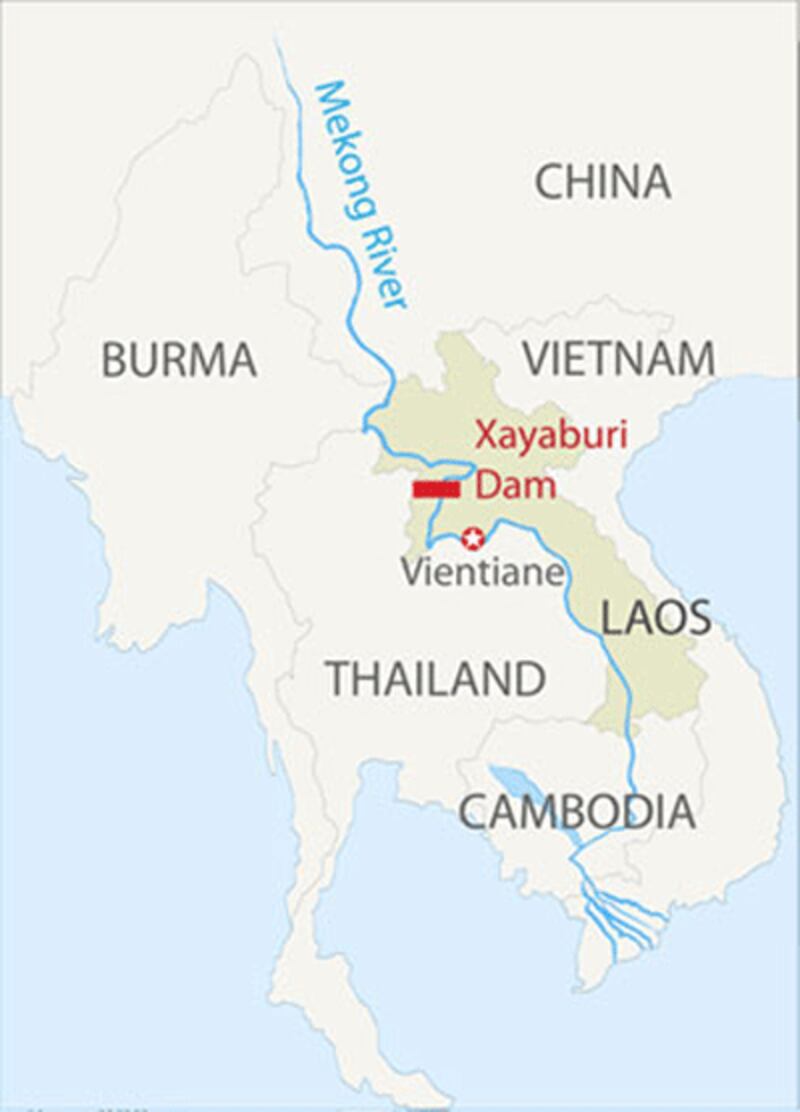Laos will conduct a new environmental study to determine the impact of a controversial dam project on the water levels and wildlife of the Mekong River, according to a Lao energy official.
Bountheung Phengthavongsa, director general of the Lao Energy and Mining Ministry, said that construction will begin on the U.S. $3.5 billion Xayaburi dam if the study predicts little effect on the river’s ecology.
“A government order has been issued that requires related authorities to seek out experts to redo the environmental impact assessment,” he said.
“The Lao government has stressed that the new study must focus on the impact of the dam on fish, on the migration of fish, and whether or not it will cause the extinction of certain species.”
The ministry official said that the study would also be used to determine whether the dam will flood villages above the reservoir or cause drought to areas below the dam.
“This means the Xayaburi dam project is still alive. If everything is OK, the government will give a green light to begin construction,” he said.
“If the result of the new study is satisfactory to all parties, Laos will build this dam right away.”
‘A difference in views’
Laos said in April it would defer a decision to begin construction on the Xayaburi after the plan met with opposition from neighboring countries, particularly Vietnam, which share the river’s resources.
Critics say the dam would destroy the river’s ecology and disrupt the livelihood of riparian communities that rely on it for their livelihood.
They also fear that proceeding with the Xayaburi dam would give a green light to construction on as many as 10 other hydropower projects planned for the lower Mekong.
At a meeting held on April 19 in the Lao capital Vientiane, officials from Cambodia, Laos, Thailand, and Vietnam issued a joint statement which said that there was "still a difference in views" and that the issue should be handled at ministerial level. A meeting is expected later this year.
Cambodia, Thailand, and Vietnam said additional studies will be required to determine the potential impact of the Xayaburi dam.
In May, Vietnam’s official media reported that Lao Prime Minister Thongsing Thammavong informed his Vietnamese counterpart Nguyen Tan Dung "of Laos' decision to temporarily suspend” the Xayaburi project.
But Laos officials did not confirm the report based on a meeting of the two leaders at the sidelines of an Association of Southeast Asian Nations (ASEAN) summit in Indonesia.
CH. Karnchang, the Thai construction company which won the bid to construct the project, has already begun to build roads on the dam site.
‘Battery of Asia’

With plans to build a total of 70 hydropower projects, Laos hopes to become “the battery” of Asia, and Thailand has already pledged to purchase 95 percent of the electricity which will be produced at the 1,285 megawatt Xayaburi dam.
The Lao government has said that the dam would not have any significant impact on the Mekong mainstream.
But the landlocked country, which hopes to kick-start its economy by harnessing the river, is facing increasing criticism over how the projects will affect the environment and its downstream neighbors.
The state media in Vietnam, Laos’ communist ally, has been particularly critical of the Xayaburi dam. Farmers in the country say the dam will decrease outflow in the Mekong delta, causing salt water from the sea to creep further into the region’s farmland and destroy crops.
Vietnam has urged a 10-year moratorium on all mainstream dams on the river.
Commission review
The Mekong River Commission (MRC), an influential intergovernmental panel, released a report in March which found that the dam would curtail the migration of anywhere from 23 to 100 species of fish. It described as “ineffective” a device proposed by CH. Karnchang to allow fish to bypass the structure.
The report also said that “under proposed operating conditions, the reservoir would effectively lose about 60 percent of its capacity due to sedimentation after 30 years,” putting the long-term ability of the dam to produce electricity in question.
Cambodia, Laos, Thailand, and Vietnam are all members of the MRC.
Activists, scientists, and officials outside of Laos say the dam would cause irreversible environmental damage, force the resettlement of 2,100 people, and impact millions of others.
In April, U.S. Senator Jim Webb, a Virginia Democrat who heads the Senate Subcommittee on East Asian and Pacific Affairs, called the dam "a dangerously harmful precedent as it relates to the environmental health of Southeast Asia."
Under an earlier agreement, Laos can proceed with the project without the approval of Cambodia, Thailand, and Vietnam, but the decision to hold off on construction may stem from the nation’s hope of gaining the support of its neighbors, all of whom are major trading partners.
China has dammed much of the upper Mekong, but few structures obstruct the rest of the 3,000-mile (4,900-kilometer) river as it continues its course through Burma, Laos, Thailand, Cambodia, and Vietnam.
Reported by RFA’s Lao service. Translated by Max Avary. Written in English by Joshua Lipes.
